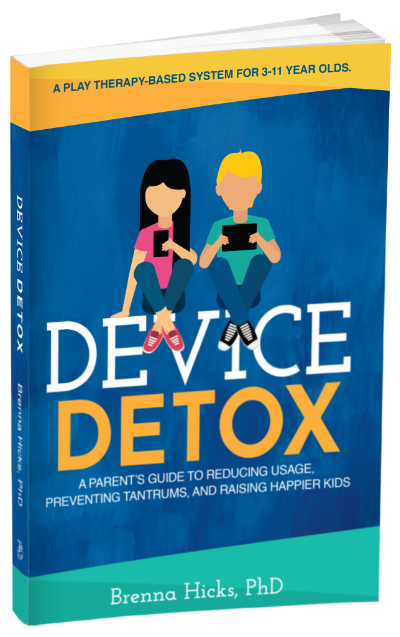The Importance of Learning to “BE” With Your Kid
Podcast Transcript
Hi, I’m Dr Brenna Hicks, founder of The Kid Counselor and Play Therapy Parenting. I wanted to share a couple of stories with you this week. Some things have really been stuck in my head and I’ve really been pondering these experiences that I had with some kids at my office and it has really resonated with me how much kids need the freedom to be. Let me give you some stories of what that looked like for me. So I’m a play therapist as many of you know, and kids come to my office and we have sessions each week. And sometimes early in the process with kids, they are unsure about the process. Sometimes later on in the process they go through a resistance where they are scared to face the things that they need to work through and so they resist going. They say they don’t want to play or they ask not to go to their sessions. It was very interesting because closely together with several different kids that I’ve been seeing, I witnessed that process for them where for different reasons they did not want to go back to the playroom.
So the first story was I walked out and I’m working with a five year old boy and he is sad and I could tell he had been crying. He was no longer crying at that moment, but there was certainly a remnent of tears there. And I walked out and mom kind of gave me a look like, “oh no.” And so I squatted down in front of him. He was sitting on the chair and – I want to pause right there because getting on a child’s level is probably one of, if not the, most important things that you can do when you’re interacting with a child because it communicates that you’re no longer above them. You’re no longer in a position of authority. You are on their level and especially if there’s emotions involved, it’s so important to be at their eye level. So I squatted down and I said, “you seem sad.” And notice my tone of voice sounded sad because your tone of voice and your facial expression when you’re meeting the child in that moment should match.
So I said, “you seem sad.” He said, “yeah, I want to go play with my brother.” And so right there I get the reason for the emotion. It was easy in that moment for me to try to distract him from that. “Well, we have so many things that we can go play!” And it’s easy to try to convince him not to feel sad. “Well, you’ll get to see your brother in a little while.” Those are the typical responses that kids receive when they are resisting something. They’re either distracted from their emotions or downplayed, and so in that moment I said, “you don’t want to go play right now because you’d like to be with your brother.” Which is exactly what he expressed to me – I just said it back to him. And he nodded and looked at me and I waited a moment and then I said, “I wonder if you’d like to go play for a little bit and then you can go see your brother when we’re all done playing.”
And he said, “OK.” We got up and started walking back to the playroom, and that struck me as a moment where I validated his feelings. I acknowledged what he was expressing and then gave him a choice. “I wonder if you’d like to go do this.” I didn’t force him. I didn’t expect him to. I just offered and he said, OK. And what’s interesting, is later when I met with mom several weeks after that, she said, “you walked back to the playroom and I called my mom and I said, ‘I just witnessed a miracle.’ She could not believe it because what would happen at home is he would get upset about something and she would try to push and try to insist that he did something and it would escalate. H would get mad and he would lose control and he would yell and he would behaviorally act out, Emotionally act out. And then she would escalate and it usually ended up erupting into this big conflict at home.
And she said, “I literally had to call my mom because I could not believe that’s what happened. And he just calmly walked off to the playroom.” So that was the first story and that was probably several weeks before this one that I’m going to share now.
So I’m working with an older boy at this point, I think he’s eight and he is a very nervous and anxious child and he was very, very fearful. This was week one, he had never met me, never played with me. Mom says, “you’re going to go play with Ms. Brenna.” And he showed up and was scared to death and I walked into the lobby and he’s hiding under the chair and mom’s trying to get him to come out. I’m trying to introduce myself and he’s saying, “I don’t want to go play with you. You’re weird. I don’t want to be here. Can I just go to school?”
And you know, making all these excuses for how he just wanted to escape. And so I think it was probably at least 15 minutes before he even decided he wanted to walk back and look at the playrooms – and notice that I said 15 minutes because I didn’t force him to. He’s there for an hour, but he wasn’t ready to go back at the start of the hour. So I sat in the lobby and I kept reflecting feelings. “You’re not sure that you want to go play. You don’t know me and it doesn’t feel safe to go back and play with a stranger. You’d rather just go to school instead of come here.” So everything he’s saying and everything he’s expressing emotionally, I’m trying to mirror that and express back to him so that I meet him where he is and I’m not setting an expectation of anything other than, “you can just be.”
“You can be worried, you can be confused, you can be sad, you can be angry, you can be whatever you are. It’s OK to just be.” So 15 or so minutes go by, he decides to come back to the room and he starts exploring some of the toys and eventually he ended up playing. And so for the last, I would say, 30 or so minutes he actually played and was in, you know, traditional therapy at that point. And then one of the standard things that we do at the end of a play session is the child gets to choose a snack. So we wrap up the session. Oh, and I forgot to mention when I gave him the five minute warning – I always tell kids we have five minutes left. He went, “Really? Time flies when you’re having fun!” That was such an amazing comment for a child who didn’t even want to come back and play.
So, again, he wasn’t forced to. It was on his own timing. It was on his own comfort level and he made the decision to come back and play. So we go into the kitchen to get a snack and he’s eating his cookie and as he takes a bite of the cookie, he says to me, “I really like this.” And I of course thought he meant he liked the cookie. So I said, “Oh, you really like the cookie for snack.” And he said, “No, I mean this” and kind of referenced my office and the play process and coming to play with me. And I said, “you decided that you do like it after all, even though it was scary at the beginning.” And that was such a significant moment for both of us because not only did he acknowledge, “I like this, even though I wasn’t sure about it,” which that takes a lot of courage for a child to admit that I had a misperception of what this was going to be. But it was a huge moment for me to realize that he came to that conclusion on his own because I didn’t push and demand and require that he do what I wanted him to do.
I would have wanted him to come, be excited to come play. I would have wanted him to be really happy that he got to play for an hour. I would have wished that he wouldn’t have been scared. I would’ve wished lots of things. And unfortunately a lot of times kids are pushed by adults in their lives to do things largely often because we as adults know that it’s good for them or know that they need to do it or know that they’ll be OK. But at the same time, by sitting there and just helping him to know what he was feeling, to hear that I heard him, that I understood him, that I could meet him in that moment, he was able to just be.
And obviously there are times when kids have to do what’s expected in the moment. You know, if it’s a safety issue, if it’s a schedule issue, sometimes there isn’t the liberty to sit down and let them be and experience what those feelings and emotions are. But oftentimes, we do have that opportunity and we miss them. So he came back the next week and played and he has since integrated well and has been continuing sessions without a problem.
Both of those so close together, they were just such a good reminder for me of how important it is to allow the child to experience what they’re experiencing with an adult present, engaged and understanding everything that’s going on in that moment and some of the other tips that I’ve given you have been to reflect feelings and to validate what the child is expressing.
That’s why it’s so important because we don’t need to solve the problem for a child. We don’t need to convince them to think or feel something different. For example, I had a parent tell me that their child came home and said, “I have no friends at school.” And so my response was, “well, I wonder what you responded.” And the mom said, “I said, ‘that’s not true. You have so and so is your friend and so and so was your friend and you know that So-and-so really likes you. They play with you all the time.’ And they went on for all the reasons why the child had lots of friends and those are probably all true. The child probably does have friends, but I said, “I wonder what your child would have thought if you would’ve said, “you feel really lonely sometimes at school.” And the mom just looked at me and said, “oh my gosh. That would’ve been the right thing to say.”
And I said, “well, I don’t know that it was the right thing to say, but it was the thing to say that communicated I get it. I genuinely truly understand what it feels like to feel like I don’t have friends and that’s lonely and it’s sad and that’s OK.” Because we have a tendency to try to change their mind or make them think something different or solve the problem for them or give them a different perspective and all of those have their place, but really in the moment the child feels the most understood and cared for when an adult just lets them sit in that experience and sit in that feeling until they are able to work through it on their own.
So I hope that encourages you. As you’re with children this week, be purposeful about that. Try to validate what they’re expressing to you in a meaningful way and just meet them in whatever that communication moment is, emotionally, behaviorally, whatever that may look like.
Don’t forget, please like me on facebook. Sign up for my email newsletter, and subscribe to my podcast on Itunes so that you will not miss any information from me. You’ll get parenting tips and play therapy principles and some other stories as I think that they’re helpful to you. So thanks for watching. And I’ll see you again soon. Bye.



